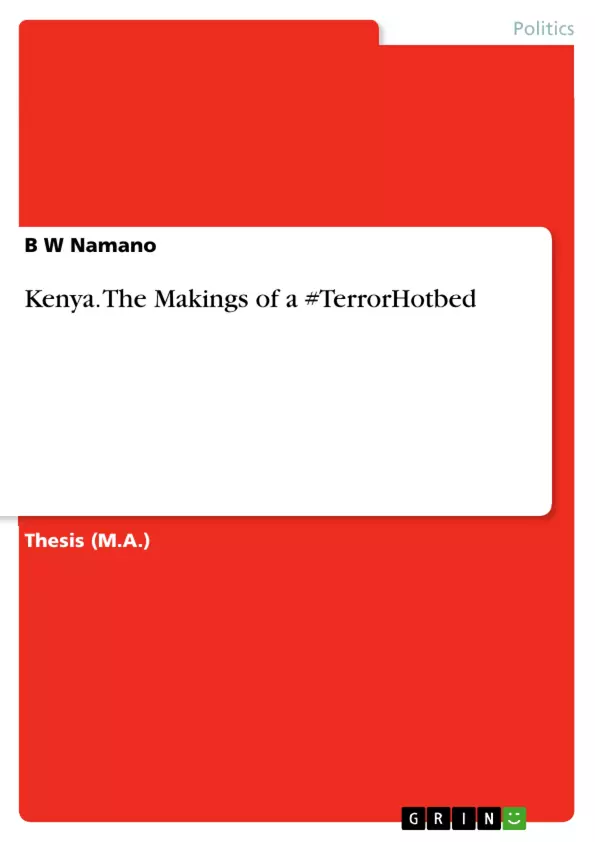Terrorism is a common contemporary phenomenon and no nation, great or not, can boast of being free of, or immune to, it. The only thing which distinguished States, on matters terrorism, is their degree of susceptibility to terror attacks i.e. the frequency with which they experience terrorism and the impact/severity of these experiences. All of us have experienced terrorism, be it directly or indirectly, and so know a thing or two on this is important, even if only for engaging in constructive deliberations on the subject.
The project seeks to establish whether Kenya is a terror hotbed, or not; and If it is, then why or rather, what makes it one; but on the other hand, if it is not, then what is it and better yet, why is it not. I intend to accomplish this fete by conducting a critical study of terrorism in Kenya, a first for the nation if I may add.
Unlike traditional methods of studying terrorism, critical terrorism studies is a research orientation that is willing to challenge dominant knowledge and understandings of terrorism, is sensitive to the politics of labeling in the terrorism field, is transparent about its own values and political standpoints, adheres to a set of responsible research ethics, and is committed to a broadly defined notion of emancipation.
By adhering to the two most essential epistemological perspectives of critical terrorism studies i.e. critical realism and reflectivism, the project makes references to historical sources, relies on facts, and analyzes hard data in a bid to reveal the underlying socio–economic and political realities, within seemingly neutral knowledge, that have long informed acts of terrorism in Kenya.
Inhaltsverzeichnis (Table of Contents)
- Introduction
- Chapter 1 Al-Qaeda Messaging America
- Chapter 2 Mungiki and the Second Liberation
- Mungiki in a Historical Context
- From Mungiki to Mungikism
- Mungiki being Mungiki
- Chapter 3 SLDF in Pursuit of Land Reforms
- Chapter 4 Al-Shabab and Fighting Terror with Errors
- Westgate Shopping Mall Attack | 21-24 Sep 2013
- Mpeketoni Attacks | 15 and 17 Jun 2014
- Mandera Attacks | 22 Nov and 02 Dec 2014
- Garissa University College Attack | 2 Apr 2015
- Chapter 5 State Terrorism: Fighting Terror with Terror
- Extrajudicial Executions
- Enforced Disappearance
- Torture
- Refoulement
- Chapter 6 Flawed Military and Defense Policies
- The Jubaland Initiative
- Military Invasion of Somalia | 16 - 22 Oct 2011
- Military Occupation of Somalia | 2 Jun 2012 - ?!
- The Great Wall of Kenya
- Chapter 7 What Data tells us about Terrorism
- Terrorism Trends and Incidences
- Casualties and Consequences of Terrorism
- Perpetrators of Terrorism
- Terror Attacks and Targets
- Chapter 8 Moving Forward
- National Security Strategy
- Violent Extremism and the TJRC Report
- Cross Functional Teams
- Border Security
- Case Management System
Zielsetzung und Themenschwerpunkte (Objectives and Key Themes)
This work seeks to provide a comprehensive analysis of the factors contributing to the rise of terrorism in Kenya, with a specific focus on the interplay of political, social, and economic forces that create fertile ground for extremism. The research explores the historical and contemporary context of terrorism in Kenya, examining various terrorist groups and their motivations. The author aims to identify key drivers of radicalization, explore the impact of government policies on the problem, and offer evidence-based recommendations for mitigating terrorism.
- The Role of Political and Social Factors in Fostering Terrorism
- The Impact of Government Policies and Security Measures
- The Impact of Terrorist Activity on Kenyan Society
- Strategies for Combating Terrorism in Kenya
- The Importance of Understanding the Dynamics of Radicalization
Zusammenfassung der Kapitel (Chapter Summaries)
Chapter 1 examines Al-Qaeda's messaging strategies in America, focusing on how their propaganda resonates with audiences and shapes perceptions of the group. Chapter 2 delves into the historical and ideological evolution of the Mungiki movement in Kenya, exploring its transformation from a social and cultural organization to a politically-motivated extremist group. Chapter 3 explores the role of land reform in fueling tensions and providing fertile ground for extremist activities, focusing on the SLDF (Saba Saba Land Defence Front). Chapter 4 analyzes the tactics and motivations of Al-Shabab in Kenya, examining specific attacks such as the Westgate Shopping Mall attack, Mpeketoni attacks, Mandera attacks, and the Garissa University College attack. Chapter 5 examines the troubling rise of state terrorism in Kenya, exploring the use of extrajudicial executions, enforced disappearances, torture, and refoulement.
Chapter 6 delves into the flaws in Kenya's military and defense policies, analyzing initiatives like the Jubaland initiative, the military invasion of Somalia, and the Great Wall of Kenya, and highlighting the shortcomings in each. Chapter 7 provides a data-driven analysis of terrorism in Kenya, examining trends and incidences, casualties, perpetrators, attacks, and targets. Chapter 8 explores a range of recommendations for moving forward, including the development of a comprehensive national security strategy, addressing violent extremism, establishing cross-functional teams, enhancing border security, and implementing a robust case management system.
Schlüsselwörter (Keywords)
The key terms and concepts explored in this text include terrorism, radicalization, extremist groups, Mungiki, Al-Shabab, Al-Qaeda, state terrorism, human rights violations, security policies, land reform, political instability, and social tensions. The work draws on a variety of sources, including government reports, media accounts, academic research, and interviews with experts in the field.
- Quote paper
- B W Namano (Author), 2017, Kenya. The Makings of a #TerrorHotbed, Munich, GRIN Verlag, https://www.grin.com/document/368375



